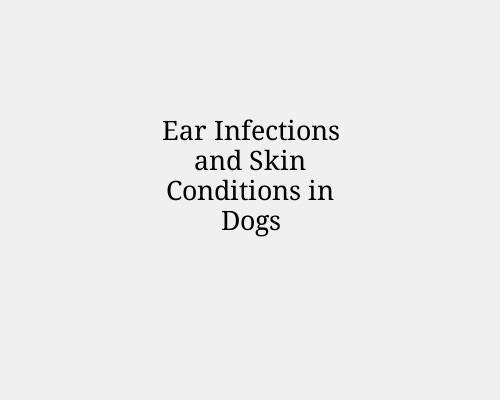Ear Infections and Skin Conditions in Dogs
Ear Infections and Skin Conditions in Dogs: Causes, Symptoms, and Treatment Options
Ear infections and skin conditions are common issues in dogs and can sometimes occur together. These problems can cause discomfort, itching, and potential complications if left untreated. Below is an overview of the causes, symptoms, diagnosis, and treatment options for these conditions.
Common Causes
Allergies
Food Allergies: Certain ingredients in dog food can trigger skin irritation and ear infections.
Environmental Allergies: Pollen, dust mites, and mold can lead to itchiness and inflammation.
Flea Allergic Dermatitis: Sensitivity to flea saliva can cause intense itching and hot spots.
Bacterial and Fungal Infections
Yeast Overgrowth: Yeast is a common culprit behind ear infections and can also cause skin irritation.
Staph Infections: Bacterial skin infections often result from broken skin or other underlying conditions.
Parasites
Ear Mites: These tiny pests can cause ear infections, leading to head shaking and ear scratching.
Mange Mites: Mites responsible for conditions like sarcoptic or demodectic mange can cause severe itching and hair loss.
Hormonal Imbalances
Hypothyroidism or Cushing’s disease can lead to skin changes and secondary infections.
Foreign Bodies
Objects like grass awns can get stuck in the ear canal, leading to irritation and infection.
Symptoms
Ear Infection Symptoms
Scratching or pawing at the ears
Shaking the head
Red, inflamed ears
Foul odor from the ear
Dark discharge or buildup
Pain or sensitivity around the ears
Skin Condition Symptoms
Persistent itching and scratching
Red, irritated, or flaky skin
Hair loss or thinning coat
Hot spots (areas of moist, inflamed skin)
Bumps, pustules, or scabs
Skin discoloration (darkened or reddened areas)
Diagnosis
Veterinary Examination
Your veterinarian will likely perform a thorough physical exam and check for signs of infection or parasites.
Diagnostic Tests
Ear Swab: A sample from the ear canal may be examined under a microscope for bacteria, yeast, or mites.
Skin Scraping: Used to check for mange mites or other skin parasites.
Allergy Testing: Can help identify triggers for allergic reactions.
Bloodwork: May be done to rule out underlying hormonal imbalances or infections.
Treatment Options
Ear Infections
Cleaning: The ear canal will be cleaned to remove debris and discharge.
Medications: Your veterinarian may prescribe topical or oral medications, such as:
Antibiotics for bacterial infections
Antifungal treatments for yeast infections
Anti-inflammatory medications to reduce swelling and pain
Ear Drops: Medications containing antibiotics or antifungal agents may be used.
Skin Conditions
Flea Control: Monthly flea prevention is essential if fleas are a trigger.
Topical Treatments: Medicated shampoos or sprays can help soothe irritated skin and reduce inflammation.
Oral Medications: Antihistamines, steroids, or newer options like Apoquel and Cytopoint may be prescribed for allergies.
Antibiotics or Antifungals: These are used to treat secondary bacterial or fungal infections.
Allergy Management: For dogs with environmental or food allergies, dietary changes or allergy immunotherapy may be recommended.
Parasite Treatment: If mites or mange are identified, appropriate antiparasitic medications will be prescribed.
Prevention
Routine Grooming: Regular baths and ear cleaning can help remove debris and reduce the risk of infection.
Flea and Tick Control: Preventing infestations can reduce the likelihood of allergic reactions and skin issues.
Balanced Diet: Ensure your dog is eating a high-quality diet that meets their nutritional needs.
Regular Veterinary Visits: Early detection of skin or ear issues can prevent complications.
When to See a Veterinarian
Seek veterinary attention if you notice any of the following:
Persistent or worsening ear or skin symptoms
Pain, swelling, or discharge from the ears
Hair loss or open sores on the skin
Any changes in your dog’s behavior or appetite
Ear infections and skin conditions are manageable with prompt diagnosis and treatment. By addressing these issues early and working with your veterinarian, you can help your dog stay healthy and comfortable.







